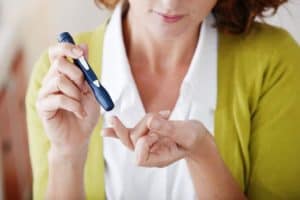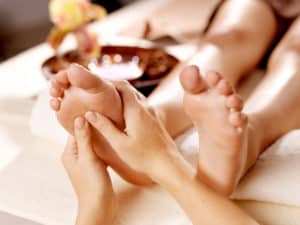

What Is Diabetes?
Broadly defined, this condition features elevated blood sugar levels and a failure to produce or utilize insulin.
There are several varieties of this condition:
- Type 1 features an autoimmune destruction to pancreatic beta cells. Formally called insulin dependent diabetes and/or juvenile diabetes. Type 1 diabetic symptoms gradually progress.
- Type 2 is the most common type featuring a failure of insulin production and/or inability to utilize what insulin the body does create. Formally called non-insulin dependent diabetes.
- “Type 1.5” involves signs and symptoms of both type 1 and 2. Usually affects people 40 years or older.
- Gestational diabetes manifests when the fetus compromises its mother’s ability to utilize sugar properly.
- Insipidus is an atypical form of diabetes, witnessing kidney failure and/or pituitary gland dysfunction.
The Cause of Diabetes
According to the American Diabetic Association, the two most common causes of diabetic conditions are obesity and sedentary lifestyle.
Other causes include: genetics, trauma, and glandular dysfunction throughout the body.
How Many People Have Diabetes?
- According to the American Diabetes Association, 25.8 million Americans suffer from some form of diabetes annually. Over 90% of cases are type 2.
- Diabetes is witnessed more in the southeastern U.S. than any other region of the nation.
- The ethnicities with the highest percentage rates of diabetes are Native-American, African-Americans, Mexican-American and Puerto Rican-American populations.
- Immediately after pregnancy, 10% of women with gestational diabetes develop type 2.
8 Classic Signs and Symptoms
- Polydipsia (increased thirst)
- Polyurea (increased urination)
- Foul and/or fruity breath
- Fatigue
- Cachexia (weight loss related due to medical condition)
- Neuropathy (abnormal nerve sensation which may or may not include pain)
- Paresthesia (“pins and needles” feeling)
- Dysfunction of both female and male erectile tissues
12 Common Complications
- Heart disease
- Hypertension
- Stroke
- Kidney disease
- Blindness/eye issues
- Neurological disease
- Amputations
- Dental disease
- Decreased immunity
- Immobility
- Depression
- Ketoacidosis
5 Tests That Can Measure Your Blood Glucose

- Fasting blood sugar (FBS) measures blood glucose after you have not eaten for at least 8 hours. It is often the first test done to check for pre-diabetes and diabetes.
- 2-hour postprandial blood sugar measures blood glucose exactly 2 hours after you start eating a meal. This is not a test used to diagnose diabetes.
- Random blood sugar (RBS) measures blood glucose regardless of when you last ate. Several random measurements may be taken throughout the day. Random testing is useful because glucose levels in healthy people do not vary widely throughout the day. Blood glucose levels that vary widely may mean a problem.
- Oral glucose tolerance test is a common test to diagnose pre-diabetes and gestational diabetes during pregnancy. This test is a series of blood glucose measurements taken after you drink a distinctive liquid that contains pure glucose.
- Glycohemoglobin (A1c) measures how much sugar adheres to red blood cells. This test can be used to diagnose diabetes, how well your diabetes has been controlled in recent months, and whether medication needs to be changed. The result of your A1c test can be used to estimate your average blood sugar level (estimated average glucose or “eAG”).
Criteria for Diagnosing Diabetes
To be diagnosed with diabetes, you must meet one of the following criteria:
- Have symptoms of diabetes and blood sugar level equal to or greater than 200 milligrams per deciliter (mg/dL). The blood sugar test is done at any time, without regard for when you last ate (random plasma glucose test or random blood sugar test).
- Have a fasting blood sugar level that is equal to or greater than 126 mg/dL.
- Have a 2-hour oral glucose tolerance test (OGTT) result equal to or greater than 200 mg/dL.
- Have a hemoglobin A1c that is 6.5 % or higher.
The diagnosis of diabetes needs to be confirmed by repeating the same blood sugar test or doing a different test on another day.
Treatment Options for Diabetes
Among the most common treatment options for Diabetics include the following medications:
- Metformis: Decreases amount of glucose released from the liver. Common side effects include: bloating, gas, diarrhea, nausea, kidney and liver failure.
- Sulfonylureas: This class of drug is known to stimulate release of insulin from pancreas. Common side effects include low blood sugar, skin rash, irritability, and nausea.
- Prandin and Starlix: Both stimulate release of insulin from pancreas. Common side effects include, effects diminish quickly, and low blood sugar.
- DPP-4 Inhibitors: Lowers blood sugar levels. A common side effect is respiratory infections.
- Alpha-Glucosidase Inhibitors: Slows breakdown and assimilation of carbs during digestion. Common side effects include, gastrointestinal pain, nausea, diarrhea, and gas.
- Pig pancreatic transplantation: Pig insulin is almost identical to human insulin.
Massage Therapist Recommendations for Clients with Diabetes

Generally speaking, Swedish massage (also known as circulatory or classic massage) may provide many benefits to diabetic patients.
The three main benefits of massage to the diabetic patient are:
- Increased circulation of blood, which allows for improved cellular intake of glucose and enhancement of insulin utilization.
- Relaxation which will relieve stresses (physical, mental and emotional) of having chronic disease and calm nervous system.
- Positive myofascial effects, which include increase mobility and improved tissue elasticity.
Before working with a diabetic client, ask yourself these questions:
Have I asked enough questions on physical symptoms and signs? (Client may have loss of sensation, skin ulcers or other complications from above list of signs and symptoms.)
Are there injection sites? (Avoid vigorous massage over recent injections. A healthy guideline is to remain three inches away from an injection site to avoid lubricant or pathogens to enter this site. Friction and other scar removal techniques over chronic sites may be indicated once the skin has regained enough integrity to avoid contaminating the injection site. )
Is there a heart or blood pressure condition with which to be concerned? (Avoid circulatory massage if heart condition or high blood pressure are witnessed in patient. Remember that Swedish massage as taught in the vast majority of entry level programs is considered circulatory in that a goal is to increase blood circulation.)
Do foot massages help diabetics? A study published in Physiotherapy Theory & Practice Journal in February 2017 indicated foot massage to diabetic patients improved balance, functional mobility and functional reach test (FRT) values. This study also recommends foot massages to be included in common rehabilitation programs for diabetic patients.
Can diabetics receive heat-based treatment including hot stone massage? (Peripheral neuropathy and skin sensitivities seen in many diabetics generally make hot stone massage and other heat-based therapies such as heating pads and warm towels unsafe for this clientele.)
How does massage affect body sugar? (Ask a client to take their blood sugar levels an hour after session to see if glucose levels raise or lower. In my experience, no two individuals witness equal effects of blood glucose levels post massage. Have clients also monitor levels of energy, fatigue, muscle pain and general mental clarity days after receiving massage sessions.)
Has client eaten recently before treatment? (Suggest eating 2-3 hours before massage treatment to avoid amplifying the effects of insulin injections if massage is administered too soon after injection.)
Ask if client carries glucose tablets or another source in case blood sugar levels drop too quickly during massage session, a hypoglycemic episode. (Keep on hand simple sugar sources such as juice or packets.)
Conclusion
Massage efforts can be beneficial to diabetic clients if protocols are designed with four fundamental goals in mind.
- First, freeing restrictions of thick, connective tissue due to a lack of mobility is key to recovery.
- Second, improving tissue elasticity with myofascial release techniques will aid greatly.
- Third, aiming to lower blood glucose levels is significant to this patient.
- Finally, improving effects of stress upon the body will be paramount, especially with a patient encountering mental, emotional, and financial strains.











